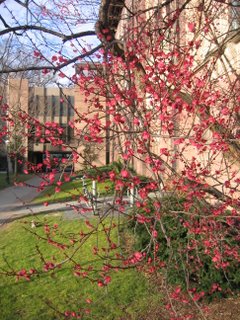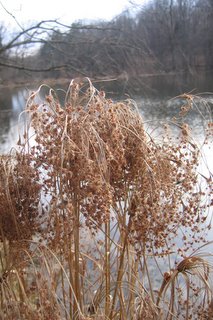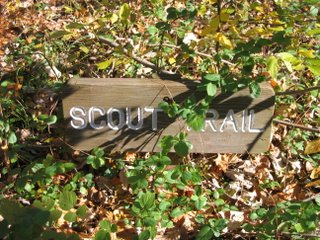
There are two kinds of common native wildflowers blooming this time of year at Mountain Lakes Preserve. Trout Lily is found mostly north of the lakes. It's leaves are spotted like trout.

Spring Beauty lines the main driveway.
News from the preserves, parks and backyards of Princeton, NJ. The website aims to acquaint Princetonians with our shared natural heritage and the benefits of restoring native diversity and beauty to the many preserved lands in and around Princeton.

The end result is a seamless carpet of this exotic species, offering none of the diversity needed to sustain wildlife. Lesser Celandine is sometimes confused with Marsh Marigold, a native that, like many natives, is rarely seen. In a month or two, the Lesser Celandine will disappear back into the ground, remaining dormant until the following spring.



 These stark forms reveal the ecological dilemma at Mountain Lakes. Invasive species + heavy deer browsing = marginalization of native species. The larger shrub to the left is multiflora rose. Deer don't like its thorns, so eat native species instead, like the diminutive silky dogwood to the right. You can see the way the dogwood has sent out lateral shoots in response to past browsing.
These stark forms reveal the ecological dilemma at Mountain Lakes. Invasive species + heavy deer browsing = marginalization of native species. The larger shrub to the left is multiflora rose. Deer don't like its thorns, so eat native species instead, like the diminutive silky dogwood to the right. You can see the way the dogwood has sent out lateral shoots in response to past browsing. A walk down the main driveway leading into Mountain Lakes provides a dramatic view of how complete has become the domination of one exotic species--multiflora rose. Walls of thorns rise on either side of this snow-covered path, ready to punish any man, woman or beast wishing to explore beyond the beaten path.
A walk down the main driveway leading into Mountain Lakes provides a dramatic view of how complete has become the domination of one exotic species--multiflora rose. Walls of thorns rise on either side of this snow-covered path, ready to punish any man, woman or beast wishing to explore beyond the beaten path. One of the perks of buying an older home is what may pop up in the yard in the spring. Here are some winter aconites (Eranthis hyemalis), a long-blooming bulb that spreads around. They're much easier to see since the English Ivy was pulled out.
One of the perks of buying an older home is what may pop up in the yard in the spring. Here are some winter aconites (Eranthis hyemalis), a long-blooming bulb that spreads around. They're much easier to see since the English Ivy was pulled out.



All of the activities will seek to connect gardeners and gardens to the broader landscape of Princeton—its nature preserves and the ecological forces at work there. One of the most disruptive forces in local preserves are the invasive exotic species--the same species that invade backyards and serve as the default landscape in untended areas.
As part of the first workshop, I brought in a newly fashioned model of the typical understory of a local preserve. Though most trees in Princeton are native, the understory is a motley crew of mostly exotic shrubs that can easily be identified in winter by various traits such as thorns, twig color, and opposite or alternate branching.
This high-tech photo of the equally high-tech model shows the pirate ship of invasives sailing the troubled ecological seas of Princeton’s greenspace.
A sequel to this posting will feature an ark of native species, currently besieged by the exotic legions but whose tide could turn with the help of some human intervention.

 Rows of cars filled the field; skaters of all abilities plied the wondrously smooth ice. One skater propelled himself with a homemade sail. A baby took to the ice in a baby carriage. Along with some pickup hockey games, there was a slippery, slidey game of soccer played slow-motion in boots.
Rows of cars filled the field; skaters of all abilities plied the wondrously smooth ice. One skater propelled himself with a homemade sail. A baby took to the ice in a baby carriage. Along with some pickup hockey games, there was a slippery, slidey game of soccer played slow-motion in boots.
 Ahh, January in Princeton. It may as well be spring. The warm weather records are breaking. The buds are bursting. And my kids will be able to tell their kids that in the old days they trudged all winter through flower blossums to get to school. In strange comfort and confusion, all of nature enters an era beyond the bounds of memory.
Ahh, January in Princeton. It may as well be spring. The warm weather records are breaking. The buds are bursting. And my kids will be able to tell their kids that in the old days they trudged all winter through flower blossums to get to school. In strange comfort and confusion, all of nature enters an era beyond the bounds of memory.
 Wild grape vine is easy to identify, with its shaggy brown bark.
Wild grape vine is easy to identify, with its shaggy brown bark.
 Ash trees have tight-grained bark. Look farther up and you'll see they have thick, opposite branching twigs.
Ash trees have tight-grained bark. Look farther up and you'll see they have thick, opposite branching twigs. Red oak has these long vertical plates. There are some towering, multi-trunked specimens at Mountain Lakes.
Red oak has these long vertical plates. There are some towering, multi-trunked specimens at Mountain Lakes. Black cherry has bark that looks like black potato chips with lots of short horizontal lines called lenticels. The lenticels help the tree to breathe.
Black cherry has bark that looks like black potato chips with lots of short horizontal lines called lenticels. The lenticels help the tree to breathe.
 Sassafras. Check out the deeply furrowed dentition.
Sassafras. Check out the deeply furrowed dentition.
 Winter, if this mild season can still be called that, is an especially appealing time to visit Mountain Lakes. The leafless trees let the light in and allow for long views across the valleys. Some of the wetland species hold their forms-- last year's sculptures held aloft as their dormant roots make plans for a new season. Woolgrass--actually a sturdy native sedge well suited for wetland gardens--is on the left. A goldenrod's seedhead is below.
Winter, if this mild season can still be called that, is an especially appealing time to visit Mountain Lakes. The leafless trees let the light in and allow for long views across the valleys. Some of the wetland species hold their forms-- last year's sculptures held aloft as their dormant roots make plans for a new season. Woolgrass--actually a sturdy native sedge well suited for wetland gardens--is on the left. A goldenrod's seedhead is below.
 Here's a typical detention basin, a required feature in any new construction. They dot the Princeton landscape, mostly at housing developments. This one happens to be at Farmview Park, a new township park on the Great Road, across from Coventry Farm.
Here's a typical detention basin, a required feature in any new construction. They dot the Princeton landscape, mostly at housing developments. This one happens to be at Farmview Park, a new township park on the Great Road, across from Coventry Farm. Here's another, more gentrified basin, brand new, nestled between the two new wings of Princeton High School. It receives not only runoff from the roof, but also gets steady infusions from the school basement's sump pump.
Here's another, more gentrified basin, brand new, nestled between the two new wings of Princeton High School. It receives not only runoff from the roof, but also gets steady infusions from the school basement's sump pump.


 (Photos from Nov. 2)
(Photos from Nov. 2) Princeton. It's not easy to capture a tree's size in a photo, but here is a tulip poplar.
Princeton. It's not easy to capture a tree's size in a photo, but here is a tulip poplar.Marquand Park also has its share of exotic trees, most of which are not of the invasive variety. Below is an otherworldly threadleaf Japanese maple, its brilliant colors backlit by an afternoon sun.
The October 28 nature walk, like those before it, was preceded by a spectacular dumping of rain that lasted long enough to insure no attendance, then stopped minutes before the scheduled start. I showed up to lead the nature walk anyway, though I was sure the weather had discouraged any and all. The big draw was the ephemeral creeks, one of which, flowing briskly alongside Valley Road, swelling into ponds where the leafpiles formed dams, nearly stalled out my car. The rain stopped right around 9am, and the surprisingly balmy mistyness had an exhilarating effect, as did the findings of an hour and a half exploring the woods of Community Park North.



 Very sturdy picnic tables that look like partially sunken battleships, and some totem-pole-shaped climbing structures surrounded by invasive thorn bushes, add a lost culture kind of feel.
Very sturdy picnic tables that look like partially sunken battleships, and some totem-pole-shaped climbing structures surrounded by invasive thorn bushes, add a lost culture kind of feel.  The Garden Club of Princeton took a walk on the wild side this week. In two brisk and sunny morning sessions organized by their Conservation Committee, ten volunteers removed invasive plants from the strip of land between the towpath and the canal, liberating native shrubs and wildflowers from an oppressive tangle of exotic weeds. The radiant fall colors of silky dogwood and winged sumac (in photo), and clear views of the water, can now be enjoyed by the many users of the path.
The Garden Club of Princeton took a walk on the wild side this week. In two brisk and sunny morning sessions organized by their Conservation Committee, ten volunteers removed invasive plants from the strip of land between the towpath and the canal, liberating native shrubs and wildflowers from an oppressive tangle of exotic weeds. The radiant fall colors of silky dogwood and winged sumac (in photo), and clear views of the water, can now be enjoyed by the many users of the path.
 Join in on a fall foliage walk through Mountain Lakes Preserve, following the new trail route that links Mountain Lakes to the Great Road, via a newly completed boardwalk. With leaves of native trees falling, it's easier to see a "second forest" of species from distant continents. Exotic species tend to keep their leaves later into the fall, so appear as a green layer in the understory. The boardwalk, built by Princeton Township with the help of a grant from the J. Seward Johnson, Sr. Charitable Trust, passes by the prairies and wetlands of Coventry Farm.
Join in on a fall foliage walk through Mountain Lakes Preserve, following the new trail route that links Mountain Lakes to the Great Road, via a newly completed boardwalk. With leaves of native trees falling, it's easier to see a "second forest" of species from distant continents. Exotic species tend to keep their leaves later into the fall, so appear as a green layer in the understory. The boardwalk, built by Princeton Township with the help of a grant from the J. Seward Johnson, Sr. Charitable Trust, passes by the prairies and wetlands of Coventry Farm.
The walk will be at 9am, Saturday, October 28. Meet at the parking lot for Community Park North and Pettoranello Gardens, just off Route 206 on Mountain Avenue in Princeton Township.
I'll be leading a nature walk along the D&R Canal towpath on Saturday, October 7, at 9am, sponsored by Friends of Princeton Open Space.
The canal corridor serves as refuge for considerable native diversity, and the D&R Canal State Park has begun managing some areas to maximize native wildflower displays. Great blue herons, giant oaks, an occasional bald eagle and 50 species of wildflowers are all to be found along the canal. Steve will help with plant ID and tell of volunteer projects underway to restore habitat and beautify the towpath.
Meet on the canal towpath at Washington Street in Princeton. Parking is available on the West Windsor side of the canal. For more information, email me via this blog.
The walk is free and open to the public.
 This pond is part of a hand-dug creekbed in a Princeton backyard. During heavy rains, runoff enters the creekbed from upstream neighbors’ yards. The runoff fills a series of mini-ponds and channels of varying depths. Most of the mini-ponds hold water for only a day or two after a rain, while others are deeper and have plastic liners in the bottom that hold water throughout the summer, providing habitat for mosquito-eating fish and various aquatic insects. The series of mini-ponds serve to hold back some of the runoff, which in turn feeds the many floodplain plant species planted in and around the ponds.
This pond is part of a hand-dug creekbed in a Princeton backyard. During heavy rains, runoff enters the creekbed from upstream neighbors’ yards. The runoff fills a series of mini-ponds and channels of varying depths. Most of the mini-ponds hold water for only a day or two after a rain, while others are deeper and have plastic liners in the bottom that hold water throughout the summer, providing habitat for mosquito-eating fish and various aquatic insects. The series of mini-ponds serve to hold back some of the runoff, which in turn feeds the many floodplain plant species planted in and around the ponds.


 It's a startling experience to suddenly be able to walk right up to a wild bird, to see the brilliance and incredible detail of their feathers close up. I found this bluejay standing quietly next to one of our backyard ponds late one afternoon this week, a few hundred feet away from busy Harrison Street. It showed no fear, no aggression. I went inside to get the camera and returned to find my daughters petting it. Only the tail feathers, bent at a strange angle, gave a clue as to why this bird did not flee our presence. The Mercer County Wildlife Center (609 883 6606) was closed, but their message said to put the bird in a shoebox and keep it there overnight without any offerings of food and water. The county naturalist (230-6439) answered his phone and suggested that the bird might be dazed from having hit a window. The tail feathers would have stayed in the position the bird was in when it hit the window. With time, the bluejay might recover its wits and fly off. This, apparently, is what happened, since it flew up into a shrub when we tried to corral it into a box, and it was gone altogether the next morning.
It's a startling experience to suddenly be able to walk right up to a wild bird, to see the brilliance and incredible detail of their feathers close up. I found this bluejay standing quietly next to one of our backyard ponds late one afternoon this week, a few hundred feet away from busy Harrison Street. It showed no fear, no aggression. I went inside to get the camera and returned to find my daughters petting it. Only the tail feathers, bent at a strange angle, gave a clue as to why this bird did not flee our presence. The Mercer County Wildlife Center (609 883 6606) was closed, but their message said to put the bird in a shoebox and keep it there overnight without any offerings of food and water. The county naturalist (230-6439) answered his phone and suggested that the bird might be dazed from having hit a window. The tail feathers would have stayed in the position the bird was in when it hit the window. With time, the bluejay might recover its wits and fly off. This, apparently, is what happened, since it flew up into a shrub when we tried to corral it into a box, and it was gone altogether the next morning.
 Two types of wild bean grow along the D&R Canal in Princeton. Groundnut (Apios americana) has reddish flowers in August followed by beans in September that look much like green beans you'd grow in your garden, but it gets its name from the edible tubers that grow along its roots. For details, see http://www.pfaf.org/database/plants.php?Apios+americana. Note that each leaf has five leaflets. Hog peanut--another leguminous vine growing along the canal--has three leaflets. Asian wistera, fortunately not common in this area, has many more leaflets than either of these two natives.
Two types of wild bean grow along the D&R Canal in Princeton. Groundnut (Apios americana) has reddish flowers in August followed by beans in September that look much like green beans you'd grow in your garden, but it gets its name from the edible tubers that grow along its roots. For details, see http://www.pfaf.org/database/plants.php?Apios+americana. Note that each leaf has five leaflets. Hog peanut--another leguminous vine growing along the canal--has three leaflets. Asian wistera, fortunately not common in this area, has many more leaflets than either of these two natives.